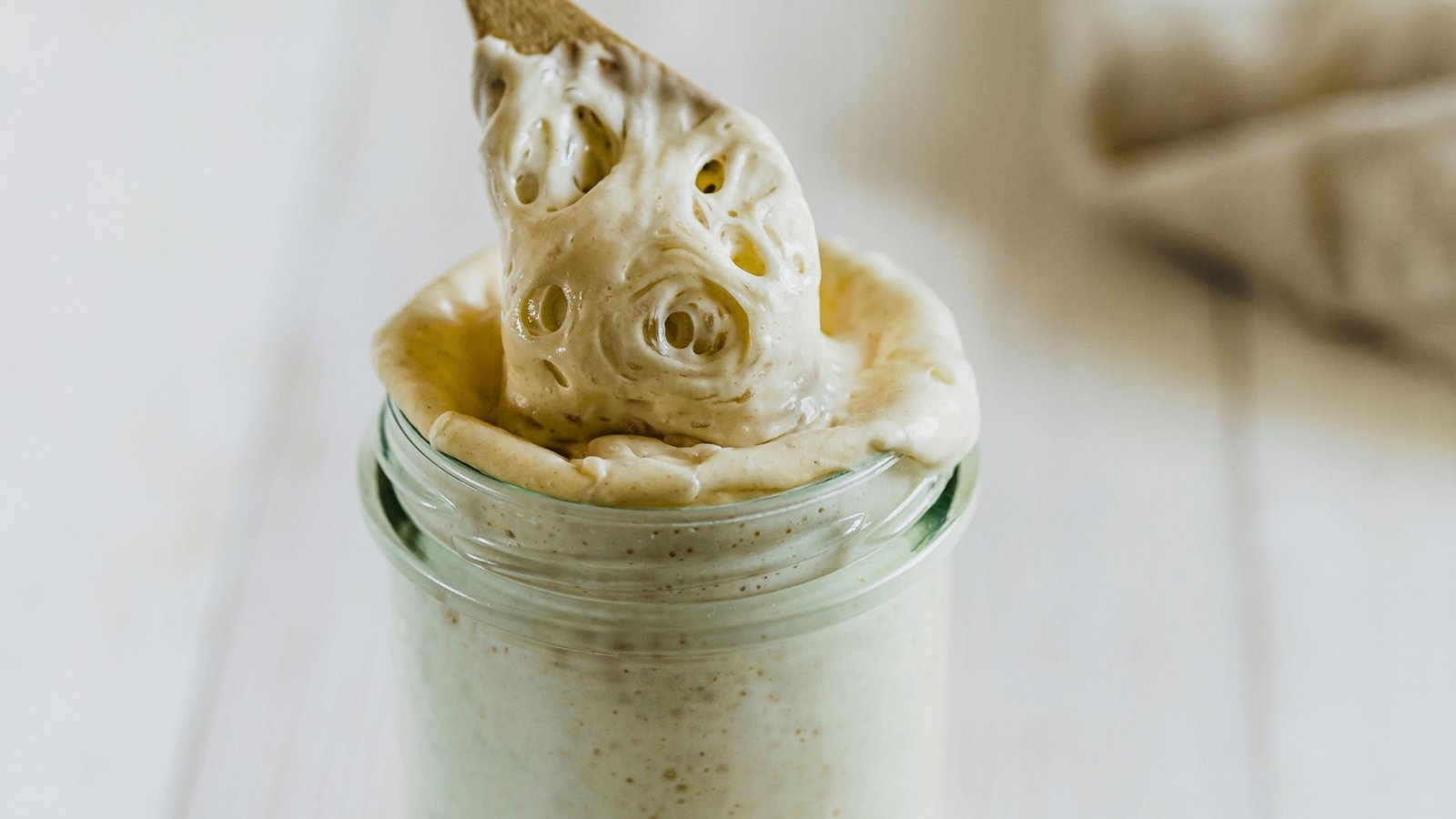Creating a sourdough starter at home or even in your van is a straightforward process that requires only flour, water, and time. This is my guide that outlines the necessary steps to cultivate a strong and healthy starter, as well as a simple sourdough bread recipe to use once it is active.
Summer is the perfect time to start a soudough in a van as you want warm and humid to get started. Once youve started it you can keep it in the fridge.
Time to start think of a name for your soughdough! It will live alongside you for a long long long time!
What Is a Sourdough Starter?
A sourdough starter is a natural leavening agent that contains wild yeast and lactic acid bacteria (primarily from the Lactobacillus species). These microorganisms naturally occur in flour and the surrounding environment. When mixed with water and fed regularly, they create a live culture capable of fermenting and raising bread.
Sourdough offers several nutritional advantages compared to conventional bread, particularly for those with mild gluten sensitivities (though it is not suitable for those with coeliac disease). The long fermentation process breaks down some of the gluten and phytic acid present in wheat, making it easier to digest and improving the absorption of nutrients such as magnesium, iron, and zinc.
The natural bacteria involved in sourdough fermentation also increase the bioavailability of amino acids, potentially enhancing protein digestibility. Furthermore, sourdough has a lower glycaemic index than standard white bread, which means it may help maintain more stable blood sugar levels. These combined factors make sourdough a beneficial choice for many people seeking more digestible and nutritionally supportive bread options.
How It Works:
- Enzymes in flour convert starches into sugars.
- Wild yeast feeds on these sugars and produces carbon dioxide, causing the dough to rise.
- Lactic acid bacteria also consume sugars, creating acids that contribute to flavour and act as natural preservatives.
Regular feeding strengthens the microbial balance, ensuring the starter can reliably leaven bread.
Required Ingredients and Equipment
Ingredients:
- Flour: Begin with whole wheat, rye, or spelt flour, which are rich in nutrients and natural yeasts. Once active, white flour can be used for maintenance.
- Water: Use filtered water or let tap water sit overnight to eliminate chlorine, which can inhibit fermentation.
Equipment:
- A glass jar or clear container
- Digital kitchen scale
- Mixing utensil (spoon, spatula, or chopstick)
- Loose-fitting lid or breathable cloth cover
Step-by-Step Guide: Building a Sourdough Starter (Day 1 to Day 7)
Day 1:
- Mix 50g whole wheat flour with 50g water in a jar (total 100g).
- Stir thoroughly and scrape down the sides.
- Cover loosely and leave at room temperature (21–24°C is ideal).
Day 2:
- Activity may vary. Proceed regardless of bubble formation.
- Discard half of the mixture (~50g).
- Add 50g white flour and 50g water.
- Mix, cover, and return to a warm location.
Days 3 to 5:
- Bubbles and a slightly tangy aroma should develop.
- Each day, discard half and feed with 50g flour + 50g water.
- Whole wheat or white flour can be used from this point.
Days 6 to 7:
- The starter should double in size within 4–6 hours of feeding.
- A bubbly surface, spongy texture, and tangy scent indicate readiness.
Youre soughdough starter is now ready to start using so keep it in the fridge and feed it weekly.
Maintenance Tips
- Use a rubber band on the jar to track rise.
- In cool environments, place the jar in the oven with the light on.
- If it smells of cheese or acetone, increase feeding or use wholegrain flour.
- Discard grey liquid (“hooch”) and feed the starter.
- Once stable, refrigerate and feed weekly.
Alternative Method: Fruit-Based Starter Using Grated Apple
Rationale:
- Apples contain natural yeasts and sugars.
- The acidity helps inhibit undesirable bacteria.
Method:
- Combine 50g grated apple (preferably organic), 50g wholemeal flour, and 50g water.
- Let sit loosely covered for 24–48 hours.
- Once active, strain out the apple and continue regular feeding.
Beginner Sourdough Bread Recipe
Ingredients:
| Ingredient | Quantity |
|---|---|
| Strong white bread flour | 500g |
| Water | 350g (70% hydration) |
| Active starter | 100g (20%) |
| Salt | 10g (2%) |
Tools Required:
- Mixing bowl
- Dough scraper
- Digital scale
- Proofing basket or floured tea towel-lined bowl
- Dutch oven or lidded cast iron pot
- Blade or sharp knife for scoring
Instructions
- Mix: Combine flour and water until incorporated. Rest 30–60 minutes.
- Add Starter and Salt: Mix thoroughly. Cover and rest for 30 minutes.
- Stretch and Fold: Over 2–3 hours, perform 3–4 sets every 30–45 minutes.
- Bulk Fermentation: Let rise until doubled (4–6 hours) or overnight in fridge.
- Shape: Pre-shape, rest 20 minutes, then shape into a round.
- Final Proof: Place in proofing basket. Proof 1–2 hours or overnight chilled.
- Bake: Preheat oven and Dutch oven to 240°C. Score and bake covered 20 mins, then uncovered for 20–25 mins at 220°C.
- Cool: Let the loaf cool completely (minimum 1 hour) before slicing.
Troubleshooting Guide
| Issue | Possible Cause | Solution |
|---|---|---|
| Flat loaf | Under-proofed or insufficient gluten | Increase stretch & folds or proof longer |
| Dense texture | Too much flour or weak starter | Handle dough gently, strengthen starter |
| No rise | Weak starter or low temperature | Warm environment, feed starter more |
| Pale crust | Insufficient baking or oven temperature | Bake longer or increase temperature |
| Overly sour taste | Mature starter or long fermentation | Use younger starter, feed more regularly |







Great guide on starting sourdough! Quick question: can you store the starter outside the fridge for a few days without feeding it, or does it always need regular feeding?
Thanks for the kind words, Eloi – glad you liked the guide!
If you’re keeping your sourdough starter at room temperature, it does need regular feeding – ideally every 12 to 24 hours – otherwise, it can become overly acidic, sluggish, or even mouldy, especially in warmer weather.
If you don’t plan to bake for a few days, it’s best to pop it in the fridge. In the fridge, your starter goes semi-dormant and only needs feeding about once a week. Just take it out, let it come to room temp, feed it, and let it get bubbly before baking again.
Room temp = daily feeding
Fridge = weekly feeding